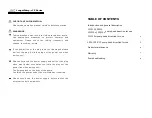
SiliCycle MiniBlock® User Guide
44
www.SiliCycle.com | [email protected]
Leakage can be caused by enlarged female luer fittings (on the Pinch-Tube Inserts). Oversized female fittings permit the male (Reaction Tube) to sink
to the bottom. This expansion can be caused by a combination of temperature and downward force of the Reaction Tubes over time. When this
occurs, the joint no longer conforms to luer specifications and leakage can occur.
Replace the female luer fittings (Pinch-Tube Inserts) with new parts. Be certain that the new Pinch-Tube Inserts are from a bag
marked with a large green dot. The green dot indicates that they have passed SiliCycle quality control tests. Leakage at the luer fitting has also
resulted from improper formation of the male luer fitting on glass reaction tubes. Glass reaction tubes should have a blue Teflon® shrink-wrap on
the luer fitting to facilitate a tight fit and luer joint sealing.
Replace any current glass Reaction Tubes which do not have a blue Teflon® shrink-wrap on the luer fitting.
A Pinch-Tube can be mechanically pulled off of the luer fitting retaining barb.
Replace the Pinch-Tube Insert.
Mechanical wear on the Pinch-Tube (caused by valve opening / closing iterations) can cause the Teflon® tube to tear, causing leakage.
Replace worn Pinch-Tube Inserts.
Failure to properly close a Pinch-Tube can have several basic causes:
A Pinch-Tube may become flattened over time. Since the SiliCycle MiniBlock closes off multiple positions simultaneously, more force is required to
close a flattened tube amid newer tubes which are dimensionally sound.
Replace any Pinch-Tube Inserts which leak in spite of normal closure (see section 3.2.6 Closing The SiliCycle MiniBlock Valve).
Periodically replace all Pinch-Tube Inserts to improve closure force evenness.
The Compression Cords, which close the Pinch-Tube, may lose elasticity. This creates permanent indentations at the Pinch-Tube contact point,
resulting in less applied force than is needed to close the Pinch-Tube. This plastic memory loss is a function of usage time and temperature. Storing
a SiliCycle MiniBlock with the valve closed will accelerate Compression Cord deterioration.
Replace Compression Cords periodically, or when indicated by systematic (multiple positions in the same row) closure failure.
Other factors may cause multiple rows of Compression Cords to apply insufficient closure force to Pinch-Tubes.
SiliCycle MiniBlock components (including Shaking Station tops and Vacuum Collection bases) are protected by an anodized layer. While this coating
makes SiliCycle MiniBlock components very resistant to physical and chemical attack, excess exposure to harsh chemicals can cosmetically mark
surfaces.
Promptly rinse all surfaces (Including Shaking Station tops and Vacuum Collection bases) after exposure to corrosive
or deposit forming chemicals.
TECH TIP
:
Do not mix Reaction Tubes with and without the blue shrink-wrap in the
same SiliCycle MiniBlock. The shrink-wrap causes the Reaction Tubes to
sit up higher in the luer fitting. When these tubes are placed in the same
SiliCycle MiniBlock as non-shrink wrapped tubes, it is difficult for a septum
to compensate for the unevenness created at the tube top. Excessive
evaporative solvent loss could result.
















































